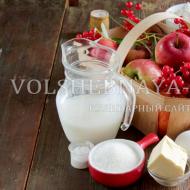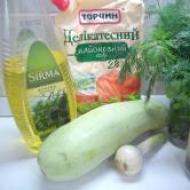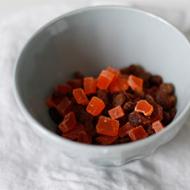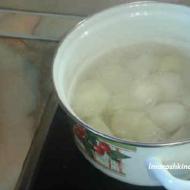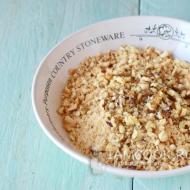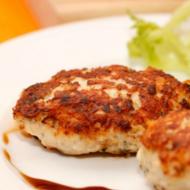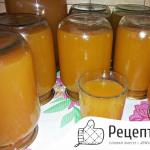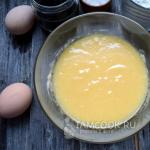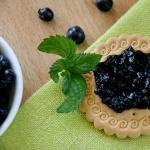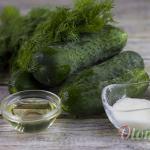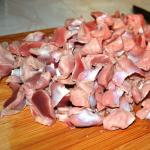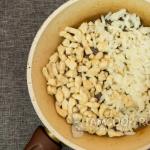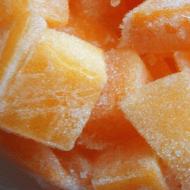
Mead is a traditional folk drink made from honey. Add your price to the database Comment. Homemade mead in two correct ways Why is mead cloudy?
The history of the preparation of alcoholic honey drinks began immediately after the development of beekeeping, as honey became stale over time, or large reserves of it appeared and, as an alternative, they began to make drinks from it.
After many centuries, the technology of preparation, strong drinks, and the taste of honey itself have undergone qualitative changes.
Let's first remember the recipe for making mead from those times according to the recipe, without yeast and pasteurization. The result will be a not very strong (5-15%) mead obtained by fermentation, which contains water, hops, yeast and other ingredients.
It is not uncommon to find fortified mead which is prepared using a different method, by adding high-quality honey to a pre-prepared alcoholic drink (vodka, purified moonshine or alcohol diluted with water).
The drink can be prepared with a pre-planned strength from 35 to 65 degrees; the favorite drink was prepared with baker's yeast, at home, from honey of all types and quality, diluting it with water. Subsequently, industrial production of mead was established in all CIS countries.
Homemade mead recipe
Components:
- honey - 300 grams
- dry yeast - 1 teaspoon, can be replaced with pressed yeast 25 grams
- hop cones - 10 grams
- water - 2 liters
- nutmeg, cinnamon on the edge of a knife.
Recipe: Take the honey that you could get, you need to take good quality aromatic varieties of buckwheat or linden. The taste of mead will depend on the quality of honey, so take it from people you trust.
Dissolve honey in water; to do this, fill a stainless or enamel container and bring to a boil. Then add honey to boiling water, stirring constantly to prevent burning; five minutes after the mixture boils, white foam will appear on the surface; you need to get rid of it by skimming it off with a slotted spoon.

Boil on a low flame, and do not leave the mixture in the pan unattended. Now you can add the ingredients from the list to the boiling water; they will fill the drink with the necessary aroma and taste.
Mix well, turn off the heat, let it brew and cool to 25-30 °C, this is the temperature of the mixture into which dissolved yeast can already be added; if the temperature of the mixture is higher, they will die.
Create conditions for fermentation, namely a dark, warm room from 18 to 30 degrees. Celsius. Monitor the temperature throughout the fermentation period, and also limit the entry of midges into the container by wrapping gauze around the neck of the container.

After a couple of days the liquid will ferment, this will be visible by the bubbles and foam on the surface, it is time to pour the wort into the fermentation tank with the lid installed.
It will take from 4 to 10 days and your mash will return, instead of sugar content, a strength in taste appears (it will stop emitting bubbles, and the mash will become ready for the next stage.
After sediment has fallen to the bottom of the tank, the finished mead must be drained through a hose, and the sediment must be filtered through gauze or in another way; let me remind you, we do this in order to separate solid particles.
Now we distribute the filtered drink into the existing prepared, clean container (glass, stainless steel) storage location (refrigerator, basement, cellar). Within a few days of resting in the container, the mead will be ready for consumption.
Recipe for making mead without yeast and without boiling
In the old days, bread or alcohol yeast was not used in the production of alcoholic beverages; they simply did not exist; the alternative was starter cultures, that is, homemade yeast from natural berries.
Due to the presence of natural, live, wild yeast on them, the squeezed juice of the berries will ferment over time. We must remember that the cherries that you want to use to make yeast must be collected not after the rain, but at least 3-3 days after it, so that the washed-off yeast is restored on the surface of the berries.

Raisin sourdough recipe
I would like to draw your attention to the fact that it will take you a week to prepare, and to the fact that wild yeast generally dies above 15% of the sourdough strength.
Natural sourdough recipe:
- take 200 grams of dried raisins, do not wash, place in a glass jar,
- add 100 grams of honey,
- pour 800 ml of purified or boiled water. temperature of +24 degrees Celsius.
Mix everything, then cover the neck of the jar with several layers of gauze, and secure it with an elastic band, pressing it around the circumference of the neck, leave the container to infuse for up to 3 days. After the expiration date, the starter is ready and can retain its beneficial properties for 10 days, being in a cool place.
We add this starter to water in a volume of 6 liters, with honey in a quantity of 3 kg. The mead will be ready in a couple of months after the mixture has been re-melted, and its strength will not exceed 3%.
If your choice fell on cherries (strawberries or raspberries) as yeast, then it is advisable to purchase them from a private seller who does not treat the berries with chemicals that neutralize the effects of yeast.
To prepare mead, another way, place in a glass jar,
- crushed and crushed pitted cherries 4 kg,
- 1 liter of purified or boiled water, add 2 kg of honey, leave at a temperature of +24 degrees Celsius. After fermentation for 10 days, the mixture must be carefully strained into a tightly closed container and placed in a cool place for maturation for a couple of months. Get a low-alcohol carbonated drink similar to kvass or lemonade, with a slight sourness.
From the honey remaining on the wax caps, on the walls of the dishes, when melting old honeycombs, wax cuttings, a very sweet honey solution is obtained.
Optimal concentration of honey for fermentation in solution: peeled potatoes should be in suspension, that is, at some distance from the bottom.

For a 40 liter can - 1 kg of yeast. Ferments for 4-7 days at a temperature of 20-25C. At this time, do not tightly close the can lid. From 10 liters of mash you get 1 liter of alcohol with a strength of 85° (1st serving); 1 l - 65-75° (2nd portion); 1 l - 40° (3rd portion). The 1st portion contains almost no fusel oils, the 3rd must be distilled.
To obtain alcohol of even finer purity, add the same amount of water to 3 liters of alcohol and distill again.
Honey alcohol is easy to drink, its strength is almost undetectable.
For the cleaning: 50 g of birch charcoal per 1 liter of alcohol. Shake the bottle 3-4 times a day for 3 weeks. For the 4th week, let it sit and strain. Dilute with water to the desired strength.
Next, you can give the vodka the desired color.: blue vodka is infused with cornflowers, yellow with saffron, red with blueberries, purple with sunflower seeds, brown with pine nut shells.
Alcohol made with honey is an old tradition. This is previously popular drinking honey in Rus', without which holidays and feasts were not complete. From a technological point of view, there are several, if not many, recipes. The classic method is to prepare mead without yeast, using a cold method. The strength does not exceed 10 degrees, which classifies it as a low-alcohol drink.
Classic mead
Mead is obtained through the process of fermenting honey. But the composition also includes water, sometimes yeast, spices or spices. A strong drink is obtained only by adding alcohol or vodka. Moreover, you can set any strength. Excess honey in apiaries under conditions of impossibility of long-term storage led to the development of technology for its fermentation. For rapid fermentation, yeast is added to the drink during its preparation.
The classic mead recipe represents an ancient technology, different from modern technology. In addition to the absence of yeast, its peculiarity is that honey is mixed with cold water. The drink will be less strong, about 4 degrees. But the process will take longer, about 4 months. The mixture of honey and water itself will not ferment, so additives must be made that essentially replace yeast - fermentation catalysts. Such additives can be berries traditionally involved in winemaking processes: cherries or dried grapes (raisins). And also raspberries. According to the historical recipe, mead was made with the addition of cherries. But for many, raisins will seem like a more familiar additive that causes fermentation.
First, a method for making mead with raisins.
- Mix water with honey: 1 liter + 80 grams. Add 50 grams of raisins. The water should be cold, not hot. There is no need to wash raisins, since they contain fermentation substances (wild yeast).
- Having put everything in a container, for example, a glass jar, we tie the throat with gauze to prevent dust or insects from entering. We place the jar in a warm place and wait for the start of fermentation, which will occur in a day or two.
- When fermentation occurs (foam, hissing), the contents are filtered. The liquid part is separated from the raisins and impurities through several layers of gauze. The filtered composition is poured into a clean jar, which is tightly sealed.
- The next stage is ripening. The jar or bottle is moved to a cool place, such as a refrigerator or basement. Staying there for up to 4 months, the drink comes to full readiness. After that you can try it. As already mentioned, the effect will be low-alcohol, similar to kvass.
Mead with cherries
Cherry mead is essentially cherry wine with honey.
Product composition
- water - 1 liter;
- cherries, seedless berries - 4 kg;
- honey - 2 kg.
How to do
Prepare the cherries: remove the pits. Dilute honey with water and pour this mixture over the cherries. Mead is prepared similarly with strawberries and raspberries. After the first stage of mixing the ingredients, the actions are exactly the same as in the honey drink with raisins (recipe above).
Mead with yeast
If you make mead according to a historical recipe without yeast, this does not mean that it will turn out to be the most delicious of all the options. At home, you can use more modern recipes for preparing a low-alcohol drink with honey.
Homemade mead - ingredients list
The composition of the products is as follows:
- 300 grams of honey;
- 2 liters of water;
- 1 tsp. yeast (dry);
- 5 grams of hops;
- various spices - 1 pinch each.
Hops are sold in pharmacies as a medicinal plant. A teaspoon of dry yeast (for example, baker's yeast) is replaced with 25 grams of pressed yeast, if such is available.
Stages of preparing mead with yeast, homemade
It is assumed that the recipe for mead at home is more often used by those who have honey in abundance. For example, these are the beekeepers themselves, who know many recipes for consuming and processing honey. But if you want to buy honey and make a drink, then it will be useful, based on the healing properties of honey. The process of selecting the honey that will be included in the mead recipe is important. Firstly, it must have a strong aroma, like buckwheat, linden or acacia nectar. Secondly, for a good honey drink you need high-quality honey. Unscrupulous sellers may change the composition of honey sold with sugar additives. You need to have a good understanding of honey when purchasing and use trusted trading sources.
- You need to mix honey and water, dissolving the first in the second. To do this, bring the water to a boil in an enamel bowl. Add honey to the boiling pan and stir. After about 5 minutes foam will appear. We remove it with a spoon to ensure transparency, and constantly monitor the process.

- Add aromatic spices and hops. Mix again and remove the pan.
- Let the liquid cool. The temperature should be slightly above normal room temperature when you need to add the yeast. High temperature will spoil the action of yeast (more than 50 degrees), and low temperature will not activate it either. The yeast must first be diluted in a minimum amount of warm water or honey syrup. Leave the pan in a warm room, in the dark. The temperature should be about 25 degrees - but that’s how it goes. Anyway, there are aquarium heaters that you can use.
 The pan is tied with gauze to prevent insects from accidentally getting in. Fermentation begins after 1 or 2 days. This is foam on the surface, hissing. At this time, you need to pour the liquid into another container, such as a bottle or jar. A rubber glove is usually placed over the throat, making a tiny hole in the finger. And also for this there is a water seal - a hose passing through the lid. One end of the tube hangs above the surface of the drink, and the other is immersed in a small jar of water. This design allows air and gases to escape from the bottle.
The pan is tied with gauze to prevent insects from accidentally getting in. Fermentation begins after 1 or 2 days. This is foam on the surface, hissing. At this time, you need to pour the liquid into another container, such as a bottle or jar. A rubber glove is usually placed over the throat, making a tiny hole in the finger. And also for this there is a water seal - a hose passing through the lid. One end of the tube hangs above the surface of the drink, and the other is immersed in a small jar of water. This design allows air and gases to escape from the bottle. - Next, a fermentation process will occur, lasting up to 6 days. It will end when the glove stops filling with gases, that is, it falls off. The end can also be determined by the absence of bubbles from the water seal. The match does not go out near the surface - also a sign that the composition has fermented.

- The next step is to filter the contents, the drink is almost ready. To do this, pour the drink into another container where sediment should not fall. After filtration, the mead is strained through cheesecloth folded in layers.

- Honey alcoholic drink is ready! We pour it into glass bottles (they are better than plastic and more traditional), and seal it. In this form, freshly prepared alcohol is stored cold. To be completely ready, it is better to wait another 5 days, but you can try right away.

It is also necessary to say about precautions.
Alcoholic drinks based on honey have been known for a long time and were found among most of the most ancient peoples of Europe - the ancient Slavs, Scandinavians, Germans, Greeks, Lithuanians, Picts, Welsh and others.
In the first half of the 16th century, honey drinks began to be replaced by vodka; in subsequent centuries, their recipes, which were transmitted mainly orally, were also lost. In addition to the emergence of cheaper alcoholic beverages, a major role in the reduction in mead-making was played by the duration of preparation of the drink, calculated in years, as well as huge losses of raw materials - up to 50% of the bookmark. Moreover, for the correct preparation of honey, large volumes of bookmarks were needed, on the order of hundreds of kilograms.
Appearing later, in the 17th–18th centuries, “meads”, “medkas” and “meads”, which have survived to this day, are prepared according to different recipes and have little in common with classic honey drinks. Now the recipes for making honey drinks have been restored.
How did they drink mead in Rus'?

The very first mead in Rus' was produced by fermenting honey in barrels with berry juice. The recipe for this drink was discovered in the widely known Domostroy (880). The cooking process was quite complicated and also took a lot of time. The fact is that initially mead was made without adding yeast, so the process was very slow. Fresh honey was mixed with sour berries and left to ferment.
To make mead, honey was fermented for 15-20 years. Sometimes fermentation reached half a century.
This honey was called " set", as he stood for a long time. For this purpose, honey was sealed in barrels, sometimes they were even buried in the ground. This was the recipe for making traditional mead. Since the process was very complex and also costly, only representatives of the rich classes, princes or warriors could afford such a drink. Barrels of mead were given to newlyweds for a wedding; it was considered a very valuable gift. This drink made it possible to have fun at a wedding for a long time and not get too drunk. The strength of the mead was 8%-12%, and its taste was very delicate and sweet.
In order to simplify production, a technology for producing intoxicated and boiled honey was invented. “Intoxicated Honey” appeared 50 years later than it was staged. In addition to adding juice, they began to add hops and spices to this product so that the drink had greater strength and a pleasant taste. Intoxicated honey was prepared for a total of 3 years; it could stand for 5-8 years. This drink came to Rus' from Scandinavia, where honey drinks have been in high esteem since pagan times. It was believed that honey was sent to people by the gods; it was food for warriors and poets. The drink had a somewhat tart taste with a slight bitterness, but it was still much tastier than beer.
The next stage in the preparation of mead was the production of the so-called “ boiled honey" The first mention of it dates back to the chronicles of 996. The production of this drink was no longer so difficult; any family could afford it. First, honey was dissolved in enough water to release the sugar, then fermentation began. The honey was left to ferment for 3-7 days, then poured into containers and kept in a dark place for a week or a month. This method made it possible to significantly reduce the amount of waste during the production of the drink. The drink made from boiled honey tastes a little like beer. It was only prepared for a few weeks.
Over time, new principles for making honey drinks appeared, which were soon replaced by vodka and wine. The revival of these recipes began already in the 19th century, by which time many traditions had been forgotten. For example, a very honorable dish in Rus' was “ satiate- a sweet drink served at the end of a meal. It was from this time that the phrase “eat your fill” came about, that is, eat everything, leaving room only for “fullness.”
Honey has always been held in high esteem in Rus'. It was considered a sacred product, at one time it was even used instead of wine for communion. Before the meal, they consumed the so-called “sbiten”, which is produced by boiling honey in water with the addition of juice and spices. There was also digest- a mixture of beer and honey. Perevar was considered the lowest quality product that even the poorest people could afford.
In Mordovia they prepared the so-called “ pure", it was a drink whose production methods were similar to those of wine and beer. The main ingredient of “pure” was honey. Honey was also added to fruit and berry wines. In Ethiopia, honey drinks were called " Tezh" This is a homemade drink. Its strength is 15%-30%. It has a sweet and spicy taste.
In the 19th century, new recipes for preparing honey drinks were invented. They were diluted with water, and also mixed with vodka or alcohol, beer. It was in the 19th century that the drink began to be called “mead”, and before that it was called “drinking honey”. The next stage in the development of mead was the arrival of the USSR. Mead was now understood as an industrially produced drink, only vaguely reminiscent of an original Russian product.
Useful properties of mead

And of course, one cannot ignore the beneficial health properties of mead. Here it is enough to take into account only the vitamin and mineral composition of honey. Vitamins of groups B, A, E, K, C, many metals necessary for a variety of processes in the body - all of them are contained in mead, although in lower concentrations than in honey.
However, when honey is sterilized and subjected to any heat treatment, some of its vitamins are destroyed, so the honey produced is considered the most healthy and retains all the properties of its main component. Additives such as hops and various spices also add certain beneficial properties to mead.
The only disadvantage of mead is alcohol. In terms of strength, it is not inferior to wine, and therefore, like other medium-alcohol drinks, it has a certain negative effect on the nervous system and liver. But with careful use and compliance with measures, these negative consequences should not appear.
Mead has the following beneficial properties:
- febrifuge
- warms and disinfects the nasopharynx for sore throats and tonsillitis
- an excellent hangover remedy, as it increases urination and sweating, which in turn cleanses the body
- enhances lung ventilation, which is good for bronchitis, tracheitis, pneumonia and other respiratory diseases
- is a good remedy for the prevention of impotence, and non-alcoholic mead is useful for pregnant women (of course, in reasonable quantities)
Harm of mead and contraindications
The drink can cause harm to the body due to individual intolerance, as well as with excessive consumption. It is not recommended to consume mead for people suffering from allergic reactions to honey.
Types of mead

There are the following types of this drink:
- Stavannaya mead is a traditional drink made according to ancient recipes.
- Mead is rich or boiled - it is made by fermenting honey, which is additionally boiled.
- Hop mead is an alcoholic drink based on mead with the addition of hops.
- Fake mead is an alcoholic drink with added spices.
Depending on the strength there are:
- non-alcoholic mead;
- regular mead;
- strong mead.
Depending on the characteristics of production, mead is distinguished with the addition of ethyl alcohol or without its addition. Honey may or may not be added after preparing the drink.
Modern homemade mead
Ingredients:
- honey – 300 grams;
- water – 2 liters;
- dry yeast - 1 teaspoon (or 25 grams of pressed);
- hop cones – 5 grams;
- cinnamon and nutmeg - 1 pinch.
All ingredients are available; difficulties may arise only with hop cones. They are sold in almost every pharmacy, so this is not a problem either. You can use any yeast, for example, for baking bread.
Mead making technology

- Choice of honey. One of the most important stages, on which the quality of the finished drink largely depends. Try to choose the most fragrant varieties. Buckwheat honey is excellent, but you can use something else, such as linden honey.
In the spring, many beekeepers offer fresh liquid honey, but if you are not well versed in beekeeping, it is better not to buy it. There is a risk that instead of a natural product, dealers will sell a surrogate made from sugar, or that the honey itself will be of low quality. Such raw materials will never make delicious homemade mead.
- Dissolving honey in water. Pour water into an enamel pan and bring to a boil. Add honey to boiling water, stirring constantly with a spoon. After 4-5 minutes of boiling the honey mixture, a white foam will begin to appear on the surface, which must be carefully collected with a spoon.
Attention! Honey burns very quickly and can ignite, so the pan should not be left unattended for a minute.
- Adding flavoring additives. After the foam is removed, add other ingredients to the mixture: cinnamon, nutmeg and hops, which will give the drink original flavor notes. After mixing thoroughly, remove the pan from the heat.
- Preparing for fermentation. Cool the mixture to 25-30°C (very important) and add the diluted yeast. If you do this at a higher temperature, the yeast will die and fermentation will not begin.
Transfer the pan with the honey solution to a dark place with a temperature of about 25°C. If there is no separate room, you can use an aquarium heater. To avoid foreign substances and insects getting into the wort (flies are especially annoying in the summer), I recommend tying the pan with gauze.
After 1-2 days, signs of fermentation will appear: foam will begin to form on the surface of the mixture, and hissing will be heard. Pour the contents of the pan into a fermentation container, placing a medical glove with a hole in the finger or a water seal on the neck.
- Fermentation. As a rule, fermentation of mead lasts 4-6 days. The end of the process is indicated by a deflated glove or a prolonged absence of bubbles escaping through the water seal. Another test method is to bring a burning match to the surface of the liquid, which should not go out. There is nothing to be afraid of, the strength of the drink is only 5-10 degrees, it will not catch fire.
- Filtration and bottling. The final stage of preparation. Carefully pour the mead into another container, leaving sediment at the bottom, then strain through several layers of gauze.
Pour the finished drink into bottles (glass or plastic), seal tightly and transfer to the refrigerator or basement. I'm not a fan of storing alcohol in plastic containers, but in this case it's harmless. The strength of mead is low, so the alcohol will not interact with the plastic. Beer is sold in bottles like these. You can drink mead almost immediately after preparation, but I recommend letting it sit for 3-5 days and only then taste it.
How to make mead carbonated?

- Wash bottles (plastic or glass) well and wipe dry.
- Add honey to the bottom of each container (one and a half teaspoons per 1 liter of drink). Thanks to the honey, a slight secondary fermentation will occur, which will saturate the mead with natural carbon dioxide.
- Pour the drink into bottles, leaving 5-6 cm of free space from the neck. Seal tightly with stoppers or lids.
- Transfer the containers to a dark room at room temperature for 7-10 days. Check the gas pressure once a day and relieve excess pressure if necessary.
- Place carbonated honey in a cool place for at least 5 days to ripen.
Mead without yeast and boiling
An ancient recipe according to which our ancestors made mead. They did without yeast and diluted honey in cold water. I warn you that using this technology, preparation will take 3-4 months, and the strength of the drink will be much lower - 2-4 degrees.
The most difficult thing in this recipe is to find an adequate replacement for yeast, since honey and water will not ferment on their own. There are two options: use cherries (raspberries, strawberries) or raisins as a catalyst. Cherries are historically the right choice, but raisins are a more reliable choice. Let's consider both cases.
Cooking technology
- Dilute honey in cold water. The amount of ingredients depends on the chosen fermentation catalyst. In the case of raisins, use: 1 liter of water, 80 grams of honey and 50 grams of raisins.
If you decide to support fermentation with cherries (raspberries, strawberries), then to make mead you will need: 1 liter of water, 4 kg of cherries and 2 kg of honey. First remove the pits from the cherries, then pour in the honey solution.
Attention! Raisins and cherries should not be washed before adding to mead, otherwise you may accidentally wash away the wild yeast responsible for fermentation, and it will be difficult to predict the subsequent result.
- Tie the neck with gauze, then place the container in a warm place. Fermentation will begin in 1-2 days. Since we did without yeast (dry and baker's), it takes more time than in the first case.
- If signs of fermentation appear (see point 4 of the first recipe), filter the liquid through several layers of gauze, pour into another container and close tightly. This method is used to prepare the so-called “set mead”, which does not require a glove or a water seal.
- All that remains is to put the bottles in the refrigerator or cellar for maturation. After 3-4 months you can try the finished drink. It will turn out carbonated with a slight sourness, the alcohol is almost not felt, more like kvass.
P.S. Many people call “proper mead” a recipe without yeast or boiling. But this does not mean that the first option is not as tasty or healthy. I advise you to prepare mead using two methods, try each option, and only then draw conclusions.
How to drink mead correctly?

It would probably be completely wrong to strictly follow these rules today. Much time has passed, living conditions have changed, traditions have been partially lost. And, of course, modern drinking culture is radically different from ancient rules. But still, today you can drink mead in such a way as to get the maximum benefit and pleasure from its use and not harm your health.
- Following ancient customs, you need to drink mead on an empty stomach. A low-alcohol drink in this case serves as an aperitif (a drink with a low alcohol content, served before a meal to stimulate appetite), stimulating digestion and improving metabolism.
- The drink should be served chilled, especially in summer and hot weather (bottles should be opened with care, without shaking the contents).
- In winter, mead can be heated (do not bring the drink to a boil).
- In order to fully taste the taste of mead, you need to drink it slowly, in small sips from small glasses.
Can you get drunk from mead? If you follow manufacturing traditions, this drink always turns out to be low-alcohol. And you can drink quite a lot of it (of course, within reasonable limits) and still feel normal, even the next morning.
There is even an opinion that by drinking a glass of fortified and very chilled mead with lemon, you can get rid of a hangover. The method is very controversial. Doctors categorically do not recommend having a hangover with any alcoholic beverages.
It is necessary to take into account individual sensitivity to alcoholic beverages and the fact that modern mead makers can prepare quite strong mead. But the consequences of its use can be completely different.
How and what to eat mead with?

Let's turn to history again and see what our ancestors drank mead with.
Classic snacks were pickled lingonberries, cloudberries, cranberries, soaked apples, and salted watermelon. Pickled vegetables (cucumbers, tomatoes, cabbage with berries, rowan berries, turnips and rutabaga, onions) are the second most popular snack.
Sweet snacks such as fresh apples and currants (black and red) perfectly complemented the sweet and sour taste of the honey drink. Also served as a snack were rye and oatmeal jelly, gingerbread and meat pie.
Now, as before, it is customary to serve mead before the main feast with a hearty meal, with plenty of light snacks (savoury and sweet) or fruit. A wide variety of products are used.
It’s rare to see soaked fruits and berries on the table today. Pickled and pickled vegetables and all kinds of pickles are much more popular. Salted, dried or smoked meat, sweet pastries with cottage cheese and raisins, cheesecakes and fresh fruit are often served along with mead.
Experts do not recommend eating mead with fish and seafood. It is believed that these products are not compatible with the drink at all and can ruin the taste sensation. There is an opinion that you don’t need to eat mead at all. It is based on the fact that this drink is tasty in itself and does not require any flavor enhancers with other products.
How and with what to drink mead, whether to have a snack or not - the decision is made individually. Now they drink it in different ways: before meals, and after, and during, sometimes snacking on what they found in the refrigerator.
The main thing here is not to harm yourself and your health. And this can happen if you abuse the drink and do not take into account the possibility of an allergic reaction in those who suffer from intolerance to honey or another product included in the drink.
Along with the flourishing of beekeeping in Rus', people began to learn how to make mead. This drink is very old. He changed the recipe and cooking technology many times. Some ingredients disappeared, and new ones took their place, and only two components remained unchanged - water and honey.
Previously, the drink was low-alcohol, since it was created only to give vigor and freshness - it was not used to intoxicate oneself. But lovers of strong drinks found a way out: adding alcohol to the finished mead. The result was over 70% vol. However, such recipes will not be considered in this article.
Homemade mead without yeast
Attention! This method is a modern analogue of how this drink was prepared in Rus', so it is suitable only for patient people.
Ingredients:
- distilled water - 1000 ml;
- heather honey (necessarily natural) - 350 g;
- raisins - 500 g.
Cooking process:
- Pour water into a saucepan, place over high heat and boil for two minutes.
- Reduce the heating of the container, add honey to the liquid. Mix thoroughly until smooth.
- Remove from heat.
- Place raisins in a container for fermenting future mead - they will replace yeast. Pour the contents of the pan (it is important that it does not have time to cool).
- There is no need for a water seal; just cover the neck of the container with a gauze bandage.
- Take the container to a warm place (you can put it near the radiator, but not too close).
- The drink ferments for two days. Then the mixture must be passed through a cotton filter to avoid sediment and bottled for further storage.
- Place containers with mead in the refrigerator for three months. You should not try the drink before - the taste will be extremely unpleasant.
Homemade mead recipe with spices
Proportions (components):
- Linden honey - 1000 g;
- distilled water - 3000 ml;
- hops - 7 g;
- nutmeg - 5 g;
- fresh ginger - 11 g;
- dry wine yeast - 6 g.
How to do:

- Prepare the base - I'm full. To do this, melt the honey in a steam bath and add it to slightly warmed water (up to about 30 degrees). Mix the ingredients thoroughly.
- Use a spoon to measure the liquid level in the dish and place over low heat. Wait until it boils, periodically shaking the contents of the container to avoid burning the honey.
- Foam that forms on the surface must be removed until it stops appearing. The higher quality raw materials were used, the less scale will be released.
- After an hour, add spices. For convenience (so as not to catch the spices from the liquid at the end of cooking), pour the seasoning into a gauze napkin, wrap it and throw the resulting bag into the water.
- Measure the amount of liquid after boiling and add more water to the level that was recorded at the beginning of preparing the drink. Keep on low heat for 35 minutes.
- Remove from the stove and leave to cool at room temperature to 30 degrees.
- Scoop up a glass of future mead and dilute wine yeast in it. They are more suitable for creating homemade alcoholic drinks - this way the mash turns out to be of better quality.
- Pour the liquid into bottles, add the yeast diluted in the mixture. Install a water seal on the container and take the container to a warm place.
- When the fermentation process is complete (approximately 14-30 days), the mead should be passed through a cotton filter to get rid of turbidity and sediment.
- The drink is ready. If necessary, its sweetness is adjusted by adding fructose. Its quantity is calculated based on the taste preferences of the taster.
How to make mead from honeycombs?
The preparation process for this recipe is very simple, but it also requires a long soaking of the finished product. Not suitable for “special cases”, since if the result is unsuccessful, it will be a pity for the time spent.
Required:
- honeycomb honey - 0.5 kg;
- bee bread - 0.3 kg;
- spring water (distilled or melted) - 2050 ml.
How to do:
- Prepare a clean container to store the drink during fermentation. Pour distilled water into it. It is better to use just this one (or the key one), since without the boiling procedure, the melt liquid collected in the city is not a very pure product.
- Place the honeycomb and bee bread in the same container, mix thoroughly until the consistency is as uniform as possible.
- Due to the difficulties associated with boiling the wax, the ingredients are not heat treated. When heated, they begin to burn to the warm surface, which is why you can easily lose the dishes. Therefore, immediately after stirring, the bottle is equipped with a water seal and taken to ferment in a suitable room.
- The recipe does not require the use of yeast, so the process will take at least 1.5 months. It is recommended to stir the liquid periodically.
- At the end of fermentation, pass the mead through two filters made of three- and two-layer gauze: to remove wax and cloudy sediment. Pieces of honeycomb, however, will quickly clog it, so it is more logical to use cotton wool.
- Pour the strained drink into glass bottles. Seal them tightly and move them to a cool, dark place. A cellar or basement is ideal, but a refrigerator and a balcony are not the best storage options, since light shining on the mead will spoil its taste.
- The product will be ready after approximately 4 months of aging. If everything is done correctly, the drink will be light and refreshing.
The mead turned out too sweet - what should I do?

Preparing such a drink at home is a painstaking task and not everyone can handle it. Few manage to accomplish this task adequately the first time. Even following the recipe is not a guarantee of good taste, because the criteria for evaluating alcohol are always different. And it would not be surprising if in the end the homemade mead did not live up to expectations.
Often the drink turns out bitter, sour or cloying. People complain about the latter least often, since too much sugar gives this effect. That is, the next time you prepare honey you will need to add a little less.
In addition, homemade alcohol ferments worse if the sugar concentration is too high. Therefore, you definitely shouldn’t overdo it with the main ingredient, especially since you can’t do anything with ready-made mead. Unless it is diluted with another drink or even distilled into moonshine.
What to do if the drink is bitter?
This problem happens in two situations:
- a recipe with a high content of hops in the ingredients was taken as a basis;
- the drink was fermented, resulting in an increase in the percentage of strength.
Fortunately, this problem can be solved. It is enough to add honey diluted with water (calculate the amount according to taste). But it is important not to forget that this substance is first boiled for half an hour and only then poured into homemade alcohol, leaving it to mature.
Why is mead sour?
In such a mistake, it is no longer the recipe that is to blame, but the negligence of the one who undertook the preparation. In this case, there can be a lot of shortcomings:
- leaky container;
- fermentation too fast;
- inconsistent addition of ingredients;
- insufficient cooking time;
- using inappropriate yeast.
To make mead correctly at home, you should get a water seal, take only high-quality components and spare no time.
Having learned how to prepare this drink, you can start creating your own recipe. But for the best result, it would be a good idea to still adhere to some recommendations:

- Selection of honey. It is worth giving preference to aromatic varieties: from heather, linden, acacia or buckwheat. For those who are not well versed in raw materials, it is advisable to buy them from autumn to spring (November-April). This will significantly reduce the chances of running into an unsuccessful fake.
- Spices. Nothing will enhance the taste of a drink like they do. Here you can give yourself almost complete freedom of choice. Thyme, cinnamon, peppermint, coriander - everything your heart desires! They can be added to mead in any proportions and combinations, as long as you like the taste and aroma of the finished alcohol. In a word, experiments are welcome.
- Water. You should not take liquid from the tap. Key or at least distilled would be much better.
- Yeast. They should be purchased specifically for mead (available in online stores) or completely replaced with other products. For example, fresh berries or raisins.
- Purity of the liquid. A home-made drink often turns out cloudy, which spoils the aesthetic component. To get rid of the unpleasant sediment, the alcohol is decanted through a cotton filter.
- Water seal. There is no way to do without it when creating a fermentation product, otherwise the container will simply explode. If you don’t want to spend money, you can use homemade structures. For example, tape a medical glove to the neck of the bottle or hermetically insert a thin rubber tube into the cap, the free end of which should be placed in a container of water. Or, as a last resort, keep alcohol in a saucepan.
In general, this is almost everything you need to know about cooking - the rest is covered in the recipes. But in addition, it should be recalled about the dangers of frequent consumption of boiled honey. Some people believe that this releases carcinogens that harm the liver. Therefore, the raw materials are either heated to 50 degrees, after which they are removed from the heat, or the dose of daily use is reduced.
Essentially mead- This is the mechanical dilution of relatively small quantities of honey in water followed by fermentation.
Historical reference
In Rus', honey was part of religious and ritual ceremonies. During the marriage ceremony, the newlyweds received a 5-10 kg barrel of honey as a gift, which they were supposed to eat within a month. Honey in Rus' was loved and consumed in large quantities - this is evidenced by ancient recipes like “dilute 1.5 pounds of honey with 12 buckets of water...”, “put 16 kg of honey into 96 liters of clean river water...” There was a custom in accordance with which low-alcohol mead was specially brewed for those entering into marriage. The newlyweds drank it not only at the wedding feast, but also for 30 days after it. No other stronger drinks were allowed to be drunk. This is where the expression “honeymoon” comes from.
Mead increases potency
Studying the causes of male impotence, in the late 90s, sexologists discovered that the cause of about half of cases of non-psychogenic impotence is a dysfunction of a tiny muscle. It is located at the base, excuse me, of the organ and acts as a valve that blocks the outflow of blood that fills the cavernous bodies. It is almost impossible to pump up this muscle (since it is smooth muscle), but its performance, it turns out, depends on the saturation of the body with certain microelements. Mainly zinc. As you may have guessed, these very microelements are found in mead in such concentration and combination
Mead recipe
Boil 2 liters of water in an enamel saucepan and pour 300 g of honey into it, stir so that the honey does not burn, and boil for 3-5 minutes, skimming off the foam. You can use any honey, even if it’s a little spoiled.

After foaming stops, add 5 g of hop cones (available at the pharmacy), a pinch of cinnamon and nutmeg, stir, remove from heat and close the container with a lid. Dissolve a teaspoon of bread yeast in sweet water. After an hour, bubbles will begin to appear - the yeast is ready.
Hop cones sold at the pharmacy. It is better to use dry yeast as yeast. Yeast You can take regular store ones, or you can take beer ones. The French yeast "Saf-levure" has proven itself very well; as the label on the package suggests, it is intended not only for baking, but also for making drinks. This yeast usually comes in 100 g bags. Brewer's yeast is sold in the store.



When the honey solution has cooled to 40-50°C (if it is more, the yeast will die), pour the yeast into it, then ferment under the lid at 25°C. I placed the pan on the system unit in the area of the power supply and covered it with a towel, as a result the temperature in the pan rose to 35°C - just what the doctor ordered :) After a few hours, intense fermentation will begin - foam will form on the surface.

Water seal
It is better to carry out fermentation in a container with a water seal so that you do not accidentally end up with vinegar instead of mead. You pour the mead into a jar and close it with an airtight lid. You make a small hole in the lid and insert the hose into it. The most important thing is that such a connection is also airtight. It is necessary that the hose in the vessel with this drink is above the water level, and the other end of the hose must be lowered into some other vessel with water.

End of fermentation
I did it without a water seal - I just covered the pan with a lid. After 5 days, fermentation will end. You can check the end of fermentation in two ways: by the disappearance of foam on the surface and with the help of a match (carefully open the lid and put a burning match into the pan - if it continues to burn, then fermentation is complete - no CO 2). Pour the resulting liquid through cheesecloth into plastic bottles, filling no more than 0.9 volumes. Screw the caps on tightly and place the bottles in the refrigerator to allow the mead to settle.

After 4-5 days the drink is ready. The taste is pleasant and easy to drink. The strength of the drink is 8 degrees. The cost of the product is 20-30 rubles per 1 liter.
RECIPE DISCUSSION:
Here's some more advice, gentlemen! Very important.
Plastic bottles should be black, beer bottles. They are designed for alcoholic drinks.
Clear lemonade bottles are not intended, and the alcohol in the drink may react with the bottle.
Thanks for the recipe, I’ll finish the homemade kvass and put on some mead.
Instead of a water seal, you can use the good old method: put a rubber medical glove on the neck (or you know what, if the neck is narrow). Although there is a special container with a water seal and other bells and whistles, it is sold as part of home breweries.
As for the color of the bottles, you can also use transparent ones, no reaction is expected there, it’s just that fermented drinks don’t like light, so if you use transparent containers, you should avoid direct sunlight and all that.
Hello everyone. I also tried making mead. Although after reading the posts I realized that it was not correct. But it turned out quite well.
Instead of water, I took homemade kvass. The honey was not boiled. I just heated the kvass to dissolve the honey in it.
There is a peculiarity: the more sour the kvass, the correspondingly. The mead will be more sour. It didn’t turn out bad with Ochakovsky kvass. The sweetness disappears with homemade kvass, but not with Ochakovo kvass. The mead turns out sweet and dark.
You can use a regular drip system as a water seal :)
http://kovanova.livejournal.com/1160865.html
Old Slavonic recipe!
Hello brothers and sisters!
I share my experience:
Linden honey (preferably sour, unripe) 1 kg per 3 liters, or better yet 2 liters, mix (saturate) with spring water!
Three days before, we germinate the wheat grains, grind half and leave half as is (a handful per liter)!
We mix these components, leave for 7 days (maybe more until fermentation ends), it is better to have more free space in the container, everything will ferment and acquire a pleasant aroma, drain, filter from grains and turbidity.
Pour into bottles, seal them, then drain the liquid from the bottles, separating the dregs that have settled to the bottom (every 1-3 days)
It will come out like white wine, similar to the color of moonstone.
Prepare at least 3 liters at once, then flavor with roots and spices. I recommend perga (pergar)
according to taste, it will saturate the drink with the missing aromas lost after fermentation, when the beebread settles, shake for 3 days, and then some will settle, some will float, strain the clear drink, and now it’s honey and ready!
The longer it sits, the better it will turn out!
Sincerely, a lover of intoxicating meads!
I make mead much simpler:
I take a glass bottle with a capacity of 20 liters (I never boil honey) and pour 15 liters of boiled water cooled to 40 degrees into it.
I take 2.5 kg of honey in a saucepan and add a glass of hot (50-60 degrees) water, stir thoroughly and pour into the bottle.
I take 30-40 grams of regular yeast, dilute it in half a glass of warm water and pour it into a bottle.
I place the bottle next to the heating radiator, having first put a rubber medical glove on the neck, and be sure to pierce one or two fingers of the glove with a needle.
I cover the bottle below the neck with a warm blanket, so that the glove is on top and free. Screw the glove to the neck with a thread, otherwise it will be torn off by the released gases.
During the fermentation process, the glove will rise and “vote” as it falls - everything is ready! We put the bottle in a cool place for a day, the dregs will settle, gently lifting the bottle, pour the mead into 2 clean buckets, then pour it into plastic bottles and seal tightly.
Store in a cool place and drink chilled.
V. Ilyin
10.04.2010
Old mead
2 kg honey, 4 tbsp. water, 4-5 kg cherries
Place the honey in an enamel pan or in a bowl for making jam, add water and cook the syrup, stirring occasionally and skimming off the foam. Place the washed, pitted cherries in a narrow-necked bottle or barrel and fill it with cooled syrup. Cover the container with a damp cloth and leave in a warm room for 3 days to ferment.
When the mixture has fermented, take the bottle into the cellar and, plugging the hole with a rolled piece of canvas, leave it to mature.
After 3 months, honey is ready for consumption. However, the taste of this honey improves the longer it is aged.
Everyone knows what the expression “honeymoon” means, but not everyone knows where it came from. In ancient times, there was a custom according to which low-alcohol mead was brewed especially for those entering into marriage.
The newlyweds drank it not only at the wedding feast, but also for 30 days after it. No other stronger drinks were allowed to be drunk. This is where the expression “honeymoon” comes from; it’s a pity that many modern newlyweds do not know about this wise custom.
The easiest version of mead!!
Compound;
Water 3.l
Trembling 11.g
Honey 250.g
Cooking!! Pour warm water into a jar, add yeast and honey, mix and throw a piece of butter or margarine on top and put in a bright place at room temperature for 4 days, you can do it without kneading or margarine, just pull a clean, washed condom on top of the jar and seal it well with tape. no gases would escape!! After this, the condom will inflate for a couple of days, then deflate, then filter through gauze, put in the refrigerator, you don’t have to put it in as you like, and drink!! If you have any questions about this, please email me. [email protected]
Here is the recipe that I, a hereditary beekeeper, use.
Boiled water, room pace.
Do not skimp on honey: 1 part (volume) honey, 4 parts water.
First make a starter using raspberries (preferably wild raspberries). There is wine yeast on the surface of raspberries.
Two weeks of fermentation at a temperature not lower than 25.
2-3 months at a temperature of 17-19.
Enjoy.
This is the second year I’ve made mead like this: for 20 liters of spring water, 3 kg of light honey. I boil everything over low heat for 15 minutes. I cool it to room temperature. I add 50 grams of regular yeast. It ferments for a week. Then I put it into bottles without sediment and into the cellar. You can drink a little at a time. A month is already a serious drink. In six months, if there is any left, dessert.
2 kg of honey 5 liters of water 5 lemons 2 bottles of light beer 12 raisins 20 g of yeast I liked it, it tastes like dry wine
This is my second year making this recipe, sometimes adding different herbs. The thing turns out to be very tasty and cool, but cunning..... it seems to drink like kvass, but it quietly knocks you out. Be careful! We lost one friend (under 100 kg) completely))) He got up and didn’t come back. Showed up only in the morning. Another good thing is a very mild hangover (well, if you drink yourself to death). Verdict: COOL THING!!!
The simplest water seal is easily made from a “device for a dropper” costs 14 rubles in a pharmacy, take it from the side where the needle is, remove it, pierce it into the lid (by heating the lid with a lighter or drilling a hole or using a knife carefully, the main thing is that there is a small hole) the other end into the cup and there you go All!
In general, yes. I did everything according to the recipe, but without the hops. I recalculated everything to 1.5 liters, but used 300-330 grams of honey. It fermented for 9 days until the bubbles began to lazily come out. I made a water seal. After the first glass I sit and smile.
ZY The copper was not boiled, but only kept on the verge of boiling for 5 minutes. It turned out sweet and tasty. I will continue to experiment.
Z.Y.Y. I thank the author.
Instead of plain water, you should add the water that remains after preparing the cottage cheese; it will be much tastier and healthier.
He grew up in the village, in apiaries. With yeast, a week in advance, this is a mash with honey, not mead. The real recipe is simple. Spring water and honey. And still time. Let it brew for at least three months. The more, the stronger. Chernukha was also made in apiaries. They took a milk can of water from the stream, placed it under the linden tree without closing the lid, and during honey collection they threw in the cuttings with honey. All sorts of “living creatures” fell from the tree. But it turned out to be a killer drink. A couple of mugs were knocked down. As a rule, they made it for hired whips. But real mead cheered the heart, left the head bright, and only hit the legs.
I did something wrong twice. It doesn’t even smell like honey. The first one looks like new grape wine, the second sample is sour and bitter, although I put in almost twice as much honey.
Igor, 16.08.2011 - 17:41
#135
Igor, it won’t smell like honey there)) especially if you put in as much honey as the yeast can ferment. As a result, you will simply end up with something like dry wine. To make the sweetness greater, you need to know the alcohol tolerance parameter of the yeast in percentage of alcohol (alcohol tolerance) and measure the initial density of the fermented wort. And then, from these two parameters, calculate approximately how much sugar you will have left in the drink after fermentation.
Here is a link to the calculation table:
http://www.teddybeer.ru/home/how-to-tables.htm
The table is for beer, but it also seems to be suitable for mead. All calculations will be approximate, but they can already be used for the problem of sugar/honey into liquid
I started studying bees not so long ago, but I became interested in honey only recently. I tried many recipes, but never achieved decent results. This summer I visited a godforsaken Siberian village where I met my grandfather, who has been working with bees all his life, and of course he treated me to honey. The sweet and sour drink with a honey aftertaste really turned off my legs, but my head remained clear... Of course, I asked about the recipe, but he didn’t give it to me, but he revealed some secrets:
- he doesn’t add yeast;
- it stands for 45 days in a cool place;
- adds bee bread to sweet water
He also said that recipes for real mead are found among the Old Believers and hereditary beekeepers...
You take a flask into it, throw in 10 kilograms of honey, top up with warm boiled water and add raw yeast, 100 grams. If you have a grain, throw it in there too, it gives an unsurpassed flavor. Well, you close everything and put it in a warm place. Periodically, after 5 days, you take a sample when it’s ready, you’ll know for yourself. Then you pour it into bottles, preferably glass, and into the cellar. ;-)
A sour-bitter taste indicates that the yeast has consumed all the sugar... and “choked”)
Our people are generous, they like more and more fat))) Personally, I diluted the yeast in a glass filled 1/3 with warm, sweet boiled water, and I only put in an incomplete teaspoon of the yeast itself, that is, without a slide)
As a result, everything fermented more or less stably for 7 days, after which I decided to interrupt this process, because I don’t want to drink sour meat either)))
Here, I filtered it. This final product is now in the pantry, absorbing CO2)) The gas has to be vented from time to time.
Once again, thanks to the author! :)
It turned out something with something))) The smell is awesome, honey aftertaste and bubbles in abundance, in general, what you need)))
By the way, after filtration, you can add fresh honey dissolved in a decoction of the lemongrass herb: honey compensates for the absorbed sugar, and lemongrass adds noticeable notes of smell... and taste too)

